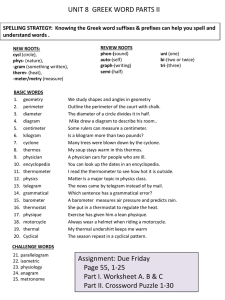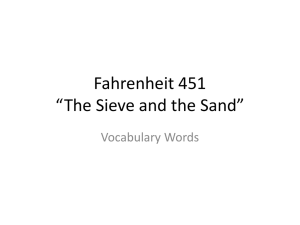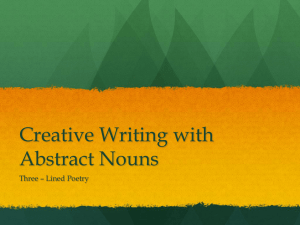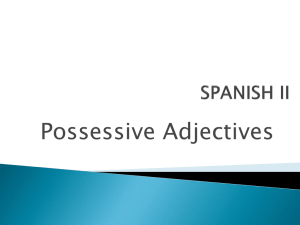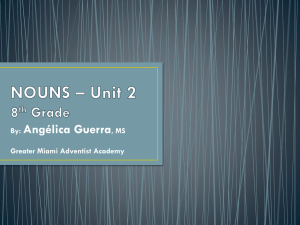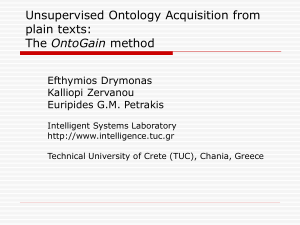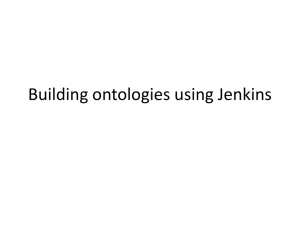Toward an Ontology of the Sumerian Language
advertisement
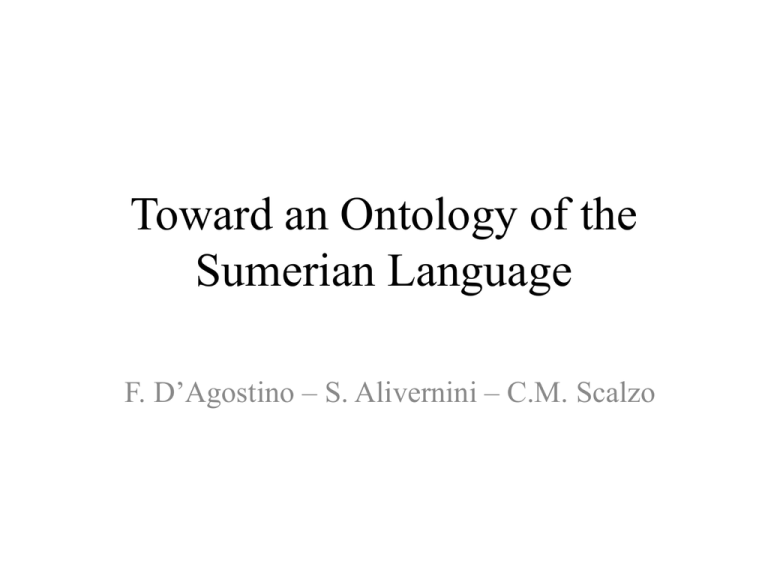
Toward an Ontology of the Sumerian Language F. D’Agostino – S. Alivernini – C.M. Scalzo Sumer at the End of the IIIrd Mill. BC Core and Periphery of Sumer Uruk IV (3200 BC ca) Uruk III (3100 BC ca) Early Dynastic I-II (2900-2650 BC ca) Early Dynastic I-II (2900-2650 BC ca) Early Dynastic III (2650-2350 BC ca) Ur III (2112-2004 BC) Ur III (2112-2004 BC) Old Babylonian Period (2000-1500 BC ca) Agglutination Latin: filiis; *fili-is *-is = 1) plur.; 2) dat.; 3) masc. *dumu-(3)nita2-(1)ene-(2)ra Ergativity lugal-e e2-Ø in(= i+n)-du3-Ø lugal-Ø i3-gin-Ø The king built a temple The king went rex templum exstruxit rex ivit The king built a temple The king went Verbal Incorporation The king drank beer in the garden with the general lugal-e1 kaš-Ø2 šagina-da3 giškiri6-a4 *i-n+da3-b+a4-n1-nag-Ø2 (FINITE VERB)-him+with-it+in-he(past, cl. A)-drink-(it) Ontology T-Box • Concepts • Hierarchy among the concepts • Properties of concepts A-Box • Facts Ontology of Sumerian Grammar T-Box A-Box Grammatical Rules All the Sumerian texts Our Ontology of Sumerian Grammar T-Box A-Box The grammar of one text The brick foundation of Ur-Namma king of Ur Our Ontology of Sumerian Grammar T-Box Nominal_Chain Possessive Case_Marker Verbal_Chain Prefix Dimensional_Infix Pronominal_Infix A-Box a-ni : Possessive mu : Prefix Brick foundation of Ur-Namma (2112-2095 BC) dNanna lugal-a-ni Ur-dNamma lugal-Urim5ki-ma-ke4 e2-a-ni mu-na-du3 bad3-Urim5ki-ma mu-na-du3 Transliteration and Translation dNanna To the God Nanna, lugal-a-ni his king, Ur-dNamma Ur-Namma, lugal-Urim5ki-ma-ke4 the king of Ur, e2-a-ni his temple mu-na-du3 built, bad3-Urim5ki-ma the walls of Ur mu-na-du3 built. Grammar of the Text dNanna noun (= god) + (dative case) lugal-a-ni noun (= substantive) + possessive adjective (a-ni) Ur-dNamma noun (= personal name) lugal-Urim5ki-ma-ke4 noun (= substantive) + genitive (noun = city+ ak) + ergative noun (substantive) + possessive adjective (a-ni) e2-a-ni mu-na-du3 bad3-Urim5ki-ma mu-na-du3 verbal chain: prefix (mu) + dimensional infix (na) + verb (du3) noun (substantive) + genitive (city + a<k>) verbal chain: prefix (mu) + dimensional infix (na) + verb (du3) Ontology of Sumerian Grammar • Final report (in pdf format): “Progetto ME. L’ontologia di una grammatica sumerica” (http://dx.doi.org/10.1683/ab0002) • Ontology in OWL format: (http://dx.doi.org/10.1683/me0004) Ur_Namma.owl Dhi Qar project Project purposes The Dhi Qar project aims at proposing a new way to manage archaeological and epigraphic finds by developing a knowledge-based cataloguing system Knowledge base • Knowledge about archaeological and epigraphic finds is represented in a knowledge base. • The knowledge base describes finds in a logical way by representing their characteristics. • Knowledge is represented as a set of concepts and their relationships (i.e., an ontology) Knowledge base Find Tablet Envelop Stamp Knowledge base Find has Shape Size Height has Width Altitude is made of Material Knowledge base • More information about finds: – Epigraphic characteristics – Visual characteristics – Dating and origin –… Knowledge base – The use of a knowledge base provides the opportunity to systematically integrate the points of view from different disciplines. – Both categories specification and observational criteria are defined by scientists of all contemplated disciplines (archeology, epigraphy, ...) – This knowledge is represented by using a formal system (Description Logics), which provides reasoning capabilities to follow the relations across the information structures, thus deriving more knowledge Accessing the knowledge base • The presence of a knowledge base makes possible to ask queries in order to facilitate the access to the catalogue • As an example, it will be possible to ask for all the scholastic tablets from a given period having circular shape. • In the same way, it will be possible to ask for all the stamps having cylindrical shape and representing human figures Input forms change dynamically with respect to the features of the find For each find in the catalogue, the user can also see a (logic-based) graphical representation of its features Contact: c.m.scalzo@epistematica.com



